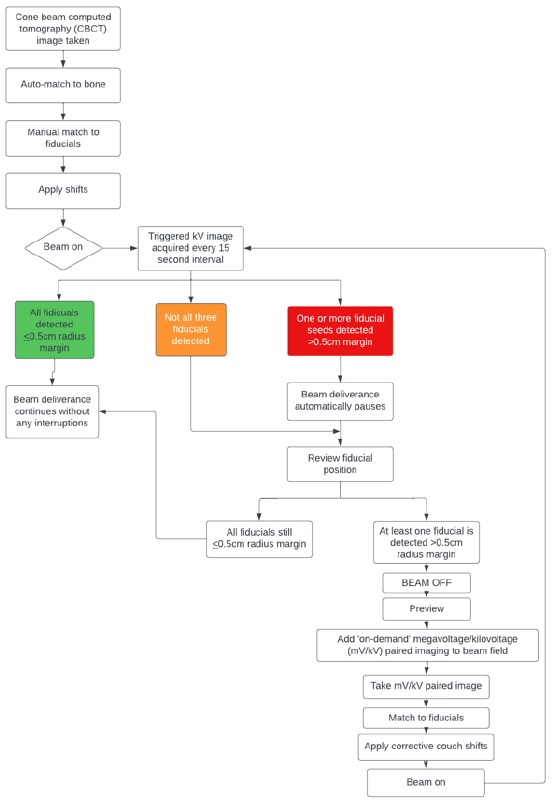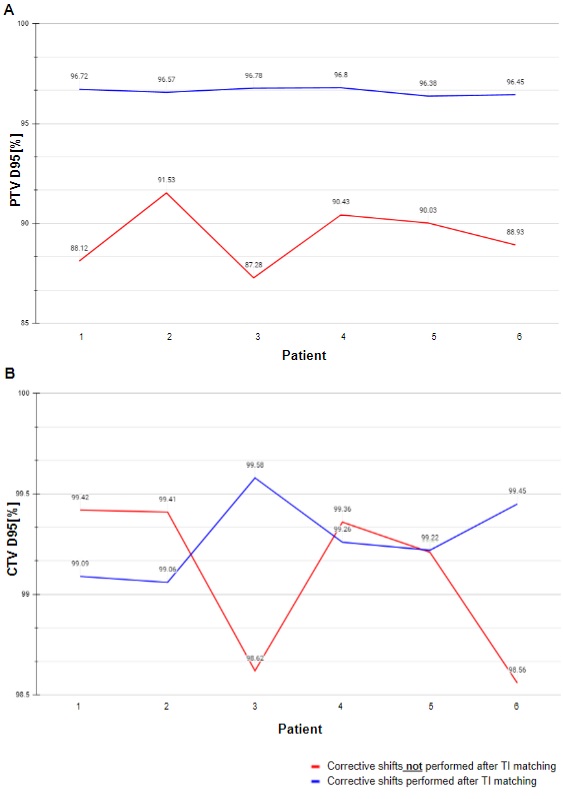VMAT-based prostate radiotherapy treatment using online triggered imaging (TI)
MO-0393
Abstract
VMAT-based prostate radiotherapy treatment using online triggered imaging (TI)
Authors: Linh Nguyen1, Tuan Vu1
1GenesisCare, Radiation Therapy, Melbourne, Australia
Show Affiliations
Hide Affiliations
Purpose or Objective
To investigate the feasibility and dosimetric effect of real-time TI for prostate cancer patients receiving volumetric modulated arc therapy (VMAT) based radiotherapy treatment.
Material and Methods
Fifteen patients were previously treated with VMAT-based radiotherapy (78Gy/39 fractions or 60Gy/20 fractions). TI is an online, real-time image verification technique used on prostate cancer patients with 3 fiducial markers.
The Varian Truebeam’s built-in program automatically detects the 3 fiducial markers during the single arc delivery, with a ‘traffic light’ system being followed at each 15-second interval image capture (Figure 1).
For the cases in the red category, the magnitude and directions of the couch shift were recorded to investigate the dosimetric impact of TI. This retrospective dosimetric analysis simulated non-TI prostate radiotherapy treatment. A duplicate plan for each of these patients was created in the Eclipse planning system, and the recorded shifts were applied in the opposite direction (anterior vs posterior, left vs right, superior vs inferior) and then calculated. To evaluate the dosimetric effect of TI, target metrics for the clinical target volume (CTV) D98%≥98% and planned target volume (PTV) D98%≥95% were compared between the deliverable plan which is represented by TI, and non-TI plan had the shifts not been applied.
To evaluate the time taken for TI radiotherapy versus non-TI, each patient’s treatment was timed from the initial set-up for TI until complete beam deliverance. This time was compared against the time taken for a non-TI cohort group of 15 prostate cancer patients using the TrueBeam Varian system.
 \
\
Figure 1
Flowchart of the 'traffic light' system.
Results
The average time taken for each treatment fraction that required no intrafractional shifts was 98.2 seconds. Out of the 15 fractions observed, 6 fractions encountered 1 beam interruption with an added average time of 145 seconds to the treatment duration. In comparison, standard non-TI prostate treatment had an average treatment time of 69.8 seconds.
Utilising the Eclipse planning system, a dose reconstruction was performed on the plan prior to the intrafractional shifts being made. The average percentage of the PTV and CTV receiving 98% total dose retrospectively decreased significantly by 7.29% and 0.17%.

Figure 2
Dosimetric evaluation of the impact of TI when performing corrective couch shifts (blue) versus no corrective shifts performed after intrafractional motion detected (red) for PTV (A) and CTV (B) D95% coverage.
Conclusion
TI in prostate radiotherapy treatment proves to be a valuable tool in monitoring intrafractional motion. While the average time taken for each fraction has increased marginally, the increased dosimetric accuracy of TI has the potential to be extended to prostatic stereotactic treatment where intrafractional motion and dosimetric accuracy has proven to be imperative.